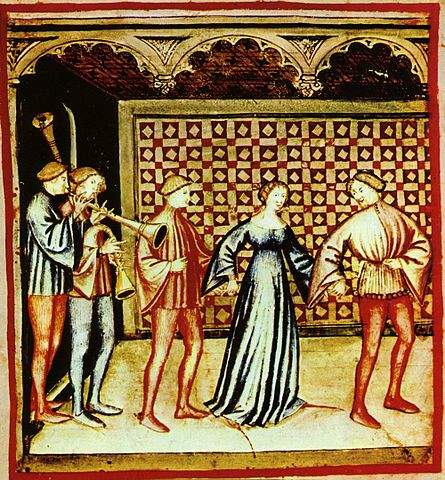
Knights, peasants, crusades, chants, and saints—this hour on Harmonia, we’ll explore elements of medieval European history, punctuated with music, of course. Plus, we’ll feature a live concert performance by The Orlando Consort from a project about Joan of Arc. Join us for a Soundtrack to the Middle Ages.
One well-known event in medieval Europe was a devastating pandemic—the Black Death. The plague began ripping through Eurasia in 1349, killing as many as 200 million.
But, let’s hear music by someone who survived this horrendous disease, French poet and composer Guillaume Machaut. His Remède De Fortune, (or The Cure of Ill Fortune), is a meditation on love, loss, and whether or not any of us can escape our fates. We’ll hear a balladelle from Machaut’s extended poem.
Ensemble Project Ars Nova performed a balladelle, “En Amer a Douce Vie,” by plague survivor Guillaume Machaut.
Feudalism
With the fall of Rome in 476, there was a transition from big empire to a medieval “go local” movement…the feudal system.
Kings granted nobles and loyal knights land, and land equaled power! Nobles managed the land, and serfs and peasants worked it, providing food and goods. In return, knights protected villages from invaders. Life was often full of war and strife, but it wasn’t all work and no play… There were times of fun and games. Festivals, feasts, and fairs, often overseen by the Church, provided some respite. And traveling musicians moved from village to village, performing songs and stories.
So, let’s have a drink and go dancing. First, we’ll hear a song from the Carmina Burana manuscript inviting Bacchus to our table, then, a dance from the French manuscript Le Manuscrit du Roi.
We heard the drinking song “Bache Bene Venies” from the Carmina Burana, performed by Ensemble Unicorn and Ensemble Oni Wytars, followed by a dance from the French manuscript Le Manuscrit du Roi, performed by Jordi Savall and Hesperion XXI.
You can’t talk about the Middle Ages without including knights in shining armor, though knights didn’t start out with all of that shiny metal. Early on, a knight was simply a warrior on horseback who wore chainmail for protection. Then over the years more pieces of metal were added until we ended up with the full regalia—and the stuff of legends. Ironically, by that time many nobles said nighty-night to knights: they were much too expensive, and gunpowder had gained widespread use.
That didn’t mean knights fell out of favor with troubadours and storytellers. Many stories boasted of a knight’s chivalry, so let’s hear a traditional ballad called The Baffled Knight. This lusty fellow’s courtesy cost him in the end—he lost his chance, you might say. We’ll hear a later version of the tale, titled “Yonder Comes a Courteous Knight”; it’s by Thomas Ravenscroft and performed by The Baltimore Consort.
That was a traditional ballad called “Yonder Comes a Courteous Knight” by Thomas Ravenscroft, performed by The Baltimore Consort.
Take Me to Church
The church was a powerful and integral part of medieval life at all social levels, and the church oversaw most celebrations and festivals throughout the year. Sacred music underwent profound change during the Middle Ages—a movement from Plainchant to one of polyphony.
Let’s hear some chant now. (We’ll hear plenty of polyphony later in the hour.) Here’s “O rubor sanguinis,” an antiphon to St. Ursula by the medieval mystic and composer Hildegard of Bingen.
We heard an antiphon to St. Ursula by Hildegard of Bingen performed by Sequentia.
The Crusades
Welcome back. We’re creating a soundtrack to the Middle Ages this hour...
It was November 27, 1095. Pope Urban II delivered a radical sermon to his assembly in Clermont, France. He proposed a “crusade,” meant to deliver Jerusalem from its Muslim rulers. He recruited an army of European pilgrims, promising them an astonishing reward: absolution from sin. Thus began almost 250 years of Crusade activity. Few understood the intricate political agendas that fueled the Crusades. Most of the citizenry believed that, indeed, Jerusalem needed to be rescued. So people joined the battle cry, left homes and families, wrote about it, painted pictures, and composed music, like this piece by Peire Vidal.
That was Ensemble Lyra - Wien, performing Peire Vidal’s crusade song “Baron, Jhesús, qu'en crotz fon mes.”
Joan of Arc
This week, our featured music is from a live concert performance by The Orlando Consort. Joan of Arc is one of the most famous figures of the Middle Ages. Voices Appeared takes music from the time of this saint’s life and weaves a musical backdrop to accompany the 1928 silent movie The Passion of Joan of Arc.
Let’s begin with the opening track, Guillaume Dufay’s “Je me complains” - with lyrics from the poem “La Ditié de Jeanne’d’Arc” by Christine de Pizan, followed by music of Richard Loqueville, Gautier Libert, and Benoit.
We heard music from The Orlando Consort’s live concert performance of their project Voices Appeared, an accompanying soundtrack to the 1928 silent movie The Passion of Joan of Arc.
Break and theme music
:30, Estampies & Danses Royales: Le Manuscrit du Roi, Hesperion XXI / Jordi Savall, Alia Vox 2008, Tr. 1 Danse (I)
:60, Estampies & Danses Royales: Le Manuscrit du Roi, Hesperion XXI / Jordi Savall, Alia Vox 2008, Tr. 2 La Prime Estampie Royal
:30, Under the Greenwood Tree, Graham Derrick/Estampie, Naxos 2000, Tr. 1 Palästinalied
Theme: Danse Royale, Ensemble Alcatraz, Elektra Nonesuch 79240-2 1992 B000005J0B, Tr. 12 La Prime Estampie Royal
The writer for this edition of Harmonia was LuAnn Johnson.
Learn more about recent early music CDs on the Harmonia Early Music Podcast. You can subscribe on iTunes or at http://www.harmoniaearlymusic.org.









